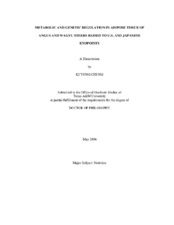Metabolic and genetic regulation in adipose tissue of Angus and Wagyu steers raised to U.S. and Japanese endpoints
Abstract
We hypothesized that carcass and fatty acid composition of Angus and Japanese Black (Wagyu) steers would not differ if the steers were fed to a typical U.S. final weight, but that Wagyu steers fed to a typical Japanese endpoint body weight would have greater quality grades and softer fat than Angus steers. Sixteen Angus and 16 Wagyu 8-month-old, weaned steers were assigned to a corn-based diet for 8 or 16 months (n = 4 per breed type and time) or hay-based diet for 12 or 20 months (n = 4 per breed type and time) in a 2 x 2 x 2 factorial arrangement. USDA yield grade was greater at the Japanese endpoint than at the U.S. endpoint in Angus steers (breed x endpoint, P = 0.03). Intramuscular (i.m.) lipid continued to increase to over 20% in the Wagyu steers (P = 0.05), but attained a plateau (14.7%) by 16 months on feed in the Angus steers. These results confirm that Wagyu cattle must be raised to greater physiological maturity before they differ from Angus cattle in M. longissimus thoracis i.m. lipid concentration. Subcutaneous adipose tissue concentrations of oleic (18:1n-9) was greater in Wagyu steers than in Angus steers (P = 0.05). All monounsaturated fatty acids (MUFA) increased between the U.S. and Japanese endpoint, whereas slip points of lipids in s.c. adipose tissue were 10°C lower in Japanese endpoint steers than in U.S. endpoint steers (P = 0.01). Angus adipose tissue exhibited peak SCD enzyme activity at 16 months (corn-based diet) but activity in Wagyu adipose tissue was greatest at 20 months (hay-based diet) (breed x diet x endpoint, P = 0.08). However, SCD gene expression in Angus adipose tissue was maximal at 12 months (hay diet), whereas Wagyu adipose tissue had peak expression at 16 months (corn diet) (P < 0.03). Trans-10, cis-12 CLA has been reported as a potent inhibitor of adipocyte differentiation. CLA (40 µM) strongly decreased SCD and PPARγ expression in bovine adipocytes, even in the presence of 5 mM arginine. It can be concluded that arginine up-regulates bovine preadipocyte differentiation, and CLA antagonizes this effect.
Citation
Chung, Ki Yong (2003). Metabolic and genetic regulation in adipose tissue of Angus and Wagyu steers raised to U.S. and Japanese endpoints. Doctoral dissertation, Texas A&M University. Texas A&M University. Available electronically from https : / /hdl .handle .net /1969 .1 /3909.


